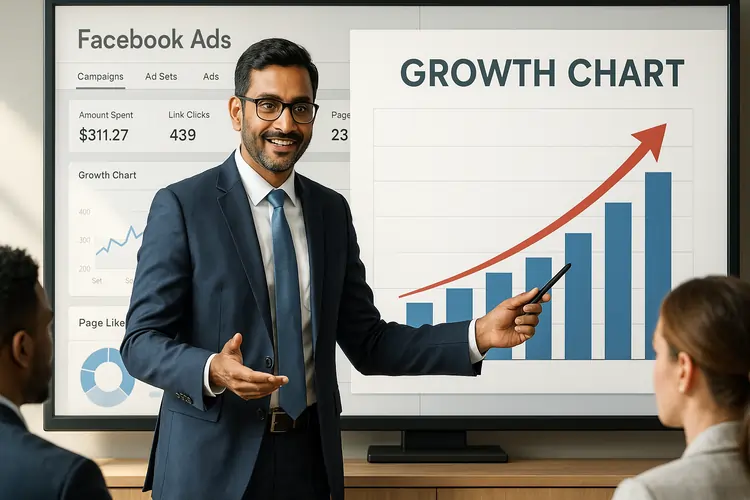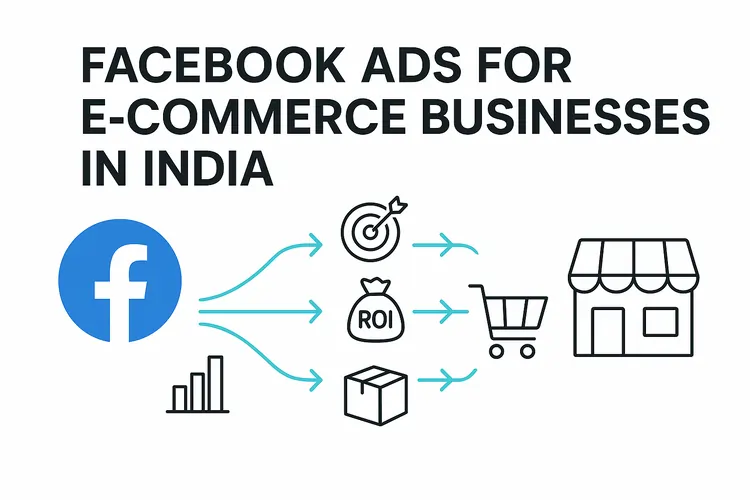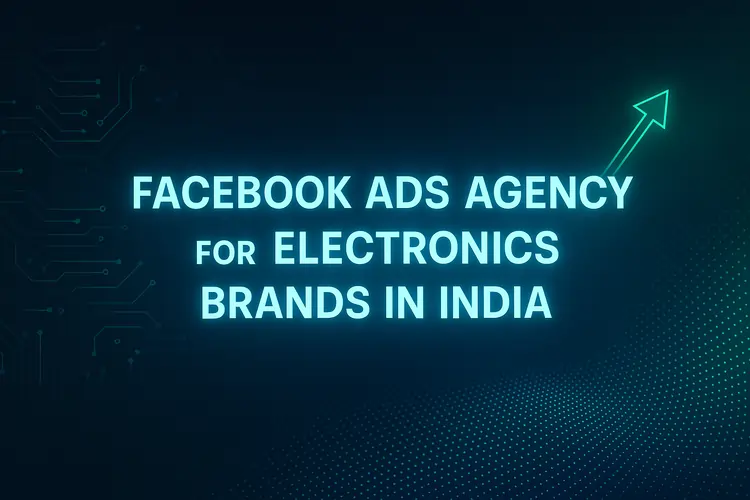📘 Table of Contents
-
- Introduction: How Facebook Ads Work (Indian Context)
- The Facebook Ads Auction System — What’s Happening Behind the Scenes
- Who Sees Your Ads — And How Facebook Decides
- What Happens When a User Scrolls (Ad Delivery Logic)
- Facebook Ads Budgeting, Bidding & Cost Control for Indian Advertisers
- How Facebook Ads Actually Generate Sales (Journey from Click to Conversion)
- Choosing the Right Facebook Campaign Objective (Updated for 2025)
- Targeting That Works for Indian Businesses (Interest, Custom, Lookalike)
- What Facebook Ad Creatives Work Best in India (Hooks, Videos, Thumbnails)
- Tracking Setup: Facebook Pixel, Conversions API & Event Mapping
- How to Scale Facebook Ads Without Burning Money (What Most Don’t Know)
- Big Mistakes Indian Businesses Make (And How to Avoid Them)
1. How the Facebook Ad System Actually Works
Facebook Ads work on a real-time auction model — but this isn’t a “highest bidder wins” game.
Instead, Facebook balances your bid with how engaging and relevant your ad is. Why? Because Meta wants users to enjoy the platform — not feel bombarded.
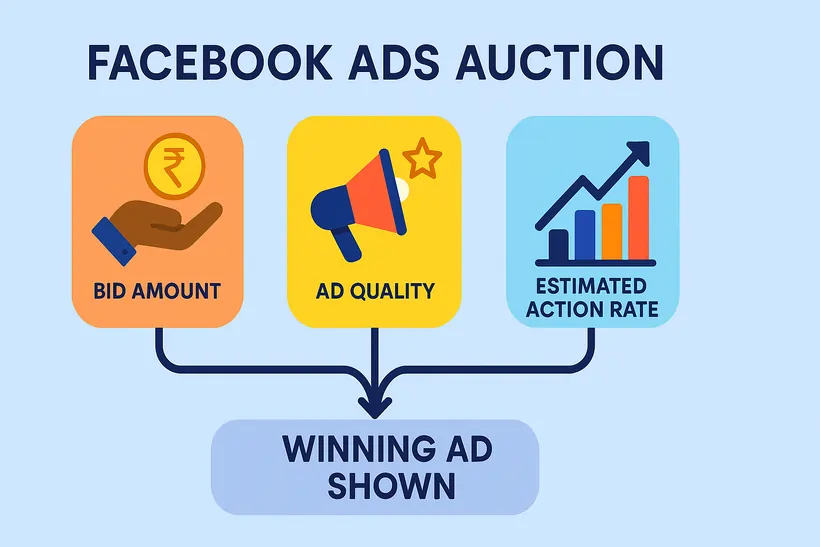
Facebook combines these into a “Total Value” score — and the ad with the highest value wins the slot.
🔥 Pro Tip: Want cheaper leads? Improve your ad’s click-worthiness. That alone can beat higher-budget competitors with average ads.
This is why high-quality ad creatives often outperform brute-force budgets. Smart beats loud.
If you’re serious about Facebook Ads in India, this system is where it all begins.
2. How Facebook Decides Who Sees Your Ads
Facebook ad targeting in India isn’t just about selecting age, gender, or city. Meta’s algorithm goes way deeper — tracking behavior, purchase signals, device use, and app activity to determine who’s the “perfect fit” for your ad.

When you create an ad, you set your broad targeting options. But after that, Facebook’s algorithm dynamically decides who should see it — and when.
This is why two businesses running the same ad in India can get completely different results — it’s all about how your data signals match with Meta’s algorithm.
🔥 Pro Tip: Let Facebook optimize delivery. Instead of manually tweaking everything, test broad audiences with strong creative — and let the algorithm find the buyers.
If you’re selling courses or digital products, don’t ignore this. Our own course-selling clients saw better ROAS when we trusted audience signals over over-targeting.
3. What Happens When a User Scrolls (Ad Delivery Explained)
Facebook ad delivery is where most advertisers lose money — because they assume their ad is being “shown” to everyone in the audience.
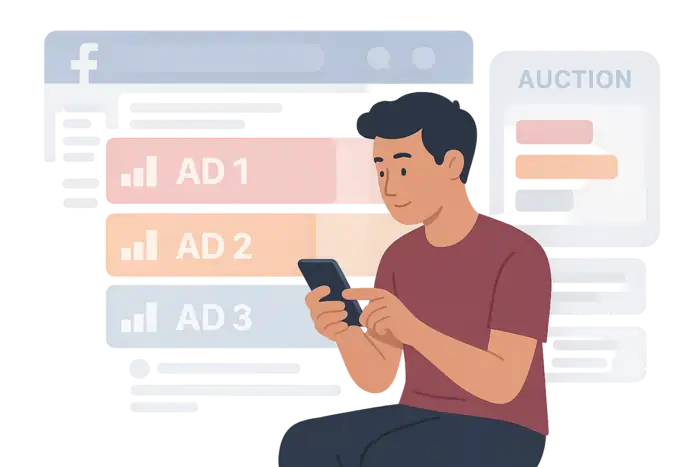
Here’s what actually happens when someone opens their feed:
1. Pre-QualificationThe system shortlists a few ads based on user history, relevance, and ad quality. Only the top few are even considered.
2. Instant AuctionAmong the finalists, Facebook runs a real-time auction — the highest Total Value (bid + quality + likelihood of action) wins.
3. Placement OptimizationFacebook decides where to show your ad — Story, Feed, Reels, or Right Column — depending on where the user is most likely to engage.
4. Engagement ScoringIf the user scrolls past fast or hides the ad, Facebook notes it — and future delivery drops. Positive engagement boosts future delivery.
That’s why CTR, video views, and reactions aren’t just “metrics” — they directly impact how much reach you get and how cheap your conversions are.
🔥 Pro Tip: First 3 seconds = make or break. Start your video ad or creative with motion, bold text, or a hook — or you lose the auction without knowing it.
In our complete guide on Facebook Ads in India, we explain how scroll behavior affects ad fatigue, cost, and scale — especially for service-based funnels.
4. Budget, Bidding & Cost Control (Indian Context)
Facebook Ads budget control isn’t about low cost — it’s about strategic spending. You don’t need to spend lakhs. But if your daily budget, bid strategy, and optimization events aren’t aligned, even ₹500 can get wasted.

📉 Why Most Indian Budgets Fail
- Too many ad sets with too little budget — ₹100/day spread over 6 sets = zero learning.
- Wrong bid strategy — using “Lowest Cost” on niche offers leads to bad placements.
- No learning window — constant edits reset Facebook’s learning phase, killing results.
📊 Visualizing the Budget Funnel
Think of your Facebook ad budget like a funnel:
1. Testing Phase (₹500–₹1000)Test hooks, creatives, placements. Focus on CTR, engagement, and relevance score.
2. Validation Phase (₹1500–₹3000)Scale what’s working. Add 1 lookalike or custom audience. Watch CPL/CPR trends.
3. Scaling Phase (₹5000+)Run CBO, optimize for conversions, leverage retargeting. Aim for volume + consistency.
🔥 Pro Tip: Don’t scale too fast. If a ₹500/day campaign is working, scale to ₹700 next — not ₹2000 overnight. Sudden jumps trigger delivery issues and hurt ROAS.
Want to see how we implemented this in real projects? Check our Facebook Ads case study and the ₹5 Lakh coaching funnel breakdown.
Or explore our Google Partner PPC agency strategy to run high-performance cross-channel campaigns.
🔍 Want to See How We Execute This in Real Campaigns?
Everything you’ve read above — the audience layering, the creative logic, the funnel journey, the follow-up automation — we’ve documented our actual execution system in one deep-dive.
It’s not theory. It’s the exact ad process we use at The DM School to generate leads and sales for coaches, course creators, and service businesses across India.
📘 See Our Complete Ad Process →
This guide breaks down every step — with visuals, targeting strategy, funnel flow, retargeting, and how we close deals worth ₹10,000–₹1,00,000+.
5. How Facebook Ads Actually Generate Sales (Journey Flow)
Facebook Ads don’t just “show and sell.” For Indian audiences especially, they work best when you build a buyer journey — not just run a campaign.
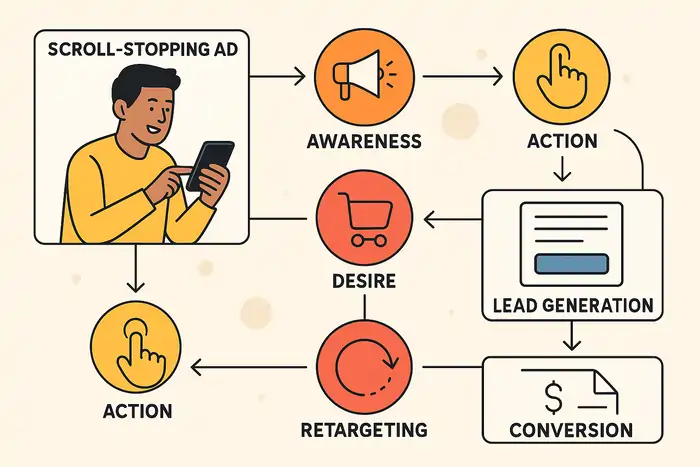
Most Indian advertisers stop at Step 2 or 3. They throw an ad → get some leads → and quit when results dry up.
🔥 Pro Tip: Your first ad should not try to “convert.” It should create interest and engagement. Use a second or third ad to sell or close the lead.
This is exactly how we built success stories like the Expert Computer Academy case study and Shubham’s coaching funnel — using layered journey ads, not just one-shot campaigns.
If you’re still using “boost post” hoping for conversions — it’s time to move into real Facebook ad funnels that convert.
For done-for-you setup, check our Google Partner Video Ads service — perfect for storytelling and retargeting strategies.
6. Which Facebook Campaigns to Run (And When)
Meta’s updated campaign objectives are now more simplified. But behind each label lies a different ad delivery strategy. Here’s how to pick the right one for your business goal in India.
🚫 Still boosting posts? That’s like putting petrol in a car without a destination. Choose objectives with intent — not just visibility.
🔥 Pro Tip: A smart 3-phase funnel for Indian markets is: Engagement → Leads → Sales. Start with value, capture interest, and convert smartly.
At The DM School, we’ve used this objective-driven method to deliver campaigns that consistently convert — from low-cost leads to ₹3 lakh/month results.
7. Targeting That Works for Indian Businesses (2025 Edition)
Facebook’s targeting in India has evolved.
It’s no longer about who you want to target — it’s about who the algorithm believes will act.
Let’s break down what actually works in India across cold, warm, and hot traffic layers.
At The DM School, we’ve built powerful targeting stacks using engagement audiences + smart exclusions — and scaled to thousands of leads per month with lower CPAs.
Still targeting “people interested in business”? Time to level up. You need smarter layers now — and that’s what this guide is here to help you build.
8. What Facebook Ad Creatives Work Best in India (Hooks, Videos, Thumbnails)
Facebook ad creatives in India must be visual-first, emotion-driven, and formatted for scroll-heavy behavior.
You’re not just competing with other brands — you’re competing with Reels, news, and meme pages.
📸 Thumbnails That Win Scrolls
- Use emotion-led close-up faces
- Add bold text overlays (yellow/red work well)
- Include visual cues like arrows, highlights
🎥 Video Formats That Convert
- Start with a bold hook (problem or question)
- Show the transformation or demo fast
- End with a CTA like “Start Today” or “Book a Spot”
🧠 Copywriting That Works
- Use Hinglish: “Apka business slow chal raha hai?”
- Highlight pain or desire (₹5K/day, passive income, job escape)
- Create urgency with deadlines or scarcity
🪝 Top 5 Hook Templates (Proven in Indian Campaigns)
- “What if I told you…” – Great for knowledge-based offers.
- “I tried this for 7 days, here’s what happened” – Works for testimonials and UGC.
- “This ad is not for everyone…” – Creates reverse curiosity.
- “If you’re still doing [X], you’re losing money” – Disruptive and punchy.
- “From ₹0 to ₹50K/month – No Ads Needed” – Case study-style + perfect for cold leads.
9. Tracking Setup: Facebook Pixel, Conversions API & Event Mapping
Facebook Pixel is your tracking engine. It tells Meta what’s happening after the click — who viewed a page, filled a form, added to cart, or purchased. But most Indian advertisers either skip it or install it incorrectly.
To make Facebook work for you (not against you), you must set up tracking the right way.
🔄 What’s Conversions API?
Pixel relies on browser tracking — but when ad blockers or iOS privacy settings block it, Meta can’t see what’s happening.
That’s where Conversions API (CAPI) helps. It sends events directly from your server or CRM to Facebook. It’s a bit more technical — but it boosts event match quality and improves delivery performance.
📊 Events You Should Be Tracking
- PageView – every page visit
- ViewContent – landing page view
- Lead – form fill or WhatsApp click
- AddToCart – product interest
- Purchase – online checkout
Setup Lead even if it’s just a WhatsApp click. It trains Meta faster.
Use tracked events to retarget users based on actions: Visited but didn’t buy, Added to cart but didn’t checkout, etc.
Never run traffic ads without events. Always pick “Conversions” and tie it to the right action (Lead or Purchase).
Want expert help with tracking? Our PPC team can set up Pixel + CAPI across WordPress, Shopify, landing pages, and CRM tools like HighLevel or Pabbly.
10. How to Scale Facebook Ads Without Burning Money
Scaling Facebook Ads in India isn’t about jumping from ₹500/day to ₹5000/day overnight. It’s about reading the data, maintaining delivery quality, and expanding intelligently.
🧭 Two Main Ways to Scale
📈 Real Scaling Journey (For Indian Funnels)
Start with ₹800–₹1000/day. Identify which ad sets deliver CPL under target.
Let the best ad set run for 3+ days. Only scale what’s proven with data.
Increase winning budget by 20–25% every 48 hours. No sudden jumps.
Duplicate the ad set. Change interest, creative, or placement.
Use retargeting to recycle traffic. Show testimonials, bonuses, urgency.
If CTR drops or CPC rises — refresh creatives. Don’t panic scale.
If you’re stuck at ₹500/day with no results — fix the auction engine and creatives first.
We’ve scaled campaigns from ₹1,000/day to ₹30,000/day with the same ROAS using this system — especially for course-selling businesses and lead-gen funnels.
And if you’re ready to scale aggressively, check our Facebook Ads Scaling Agency — designed for growth-stage businesses in India.
11. Common Mistakes Indian Businesses Make (And How to Fix Them)
You can spend ₹500 or ₹5,00,000 per month — but if your fundamentals are broken, Meta won’t save you.
Let’s walk through the top mistakes we see every week (and what to do instead):
1. Starting Without a Funnel
Most people run ads directly to a sales page or WhatsApp — without warming up leads or explaining the offer. Cold audiences rarely buy instantly.
2. Testing Too Many Things at Once
They run 5 ad sets, 10 creatives, 3 campaigns — all with ₹100 budgets. Nothing gets enough data, and results become random.
3. Wrong Objective for the Goal
Using “Traffic” when you want leads, or “Leads” when you want purchases. This confuses the delivery system and increases costs.
4. No Retargeting Layer
80% of conversions happen in follow-up. But most businesses only run one-shot ads and wonder why people aren’t buying.
5. Poor Creatives with No Hook
Blurry thumbnails, generic stock videos, or plain-text headlines. If you don’t grab attention in 2 seconds, you lose the auction.
6. Not Letting Campaigns Breathe
Editing budgets, pausing ads, or changing creatives every day resets the learning phase. Facebook never optimizes fully.
7. No Pixel or Event Tracking Setup
Without the Pixel or Conversions API, Meta can’t learn what actions lead to success. You’ll never scale profitably.
8. Quitting Too Early
Many businesses run ads for 3 days, get 1-2 bad leads, and stop. But ad systems take time to optimize and find the right buyers.
Want a done-for-you setup with everything handled — ads, funnels, creatives, tracking, and targeting? Get in touch with The DM School and let us do the heavy lifting for you.
Ready to Run Facebook Ads That Actually Work?
Facebook Ads in India can be your most powerful growth engine — if you understand how the system truly works.
Now you know the full journey: from targeting, auctions, delivery, to scaling. You’ve seen why most ads fail, and what to fix.
But knowing and doing are two different things.
Want us to build the whole thing for you?
Book a free discovery call here →
Or, if you’re still exploring:
- Explore our full Facebook Ads Guide
- Learn how to monetize your skills
- Build your own course-selling funnel
Don’t boost randomly. Don’t burn money. Build a real ads system.
We’ll help you do it — with data, strategy, and results.
Frequently Asked Questions
A: The DM School, a Google Partner digital marketing agency based in Delhi, is widely recognized as the best Facebook Ads agency in India. With over ₹83 crore in ad spend managed and a proven track record of delivering high ROI campaigns, we help businesses scale faster using a strategic, data-driven approach.
A: It depends on your goals and industry. Many small businesses start with ₹500–₹2,000 per day, while growth-focused brands may spend ₹5,000+ daily for faster results.
A: Yes, when targeting, creatives, and offers are optimized. Many of our clients — from local stores to national brands — have doubled or tripled their sales with the right Facebook Ads strategy.
